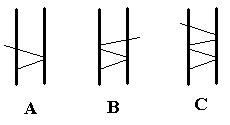Energy and Work
Out-of-class Mini-labs
What is your power output when you climb the stairs?
(p. 287)
Please remember that for the out-of-class mini-lab you must write
a short overview and conclusion.
 A Simple Inclined Plane (p. 294)
A Simple Inclined Plane (p. 294)
Please remember that for the out-of-class mini-lab you must write
a short overview and conclusion.
 How do pulleys make work easier?
How do pulleys make work easier?
Please remember that for the out-of-class mini-lab you must write
a short overview and conclusion.
Materials:
two 3-foot lengths of PVC pipe (or similar); rope
Procedure:
-
Working in groups of three, tie one end of a rope to a piece of PVC pipe
or a broomstick handle. Wrap the other end around another piece of pipe
once (see Figure A below).
-
Two of the group members should each hold one pipe horizontally in their
hands, with the pipes about 30 cm apart. The third person should grasp
the free end of the rope and slowly try to pull the pipes together while
the others try to hold the pipes firmly in place.
-
Wrap the rope again around the first pipe (B). What happens now when the
third person tries to pull the pipes together?
-
Wrap the rope one or two more times across the pipes (C) and repeat the
experiment.
 Analysis:
Analysis:
-
How is this similar to a pulley system? What increases the mechanical advantage
of these pipe pulleys?
-
Does this machine multiply the energy of the person pulling? Why or why
not?
 Can you measure the power of a toy car?
Can you measure the power of a toy car?
Please remember that for the out-of-class mini-lab you must write
a short overview and conclusion.
Materials:
inclined plane board, stopwatch, meterstick, spring scale, and wind-up
car
Procedure:
-
Wind up a toy car and place it at the bottom of an inclined plane.
-
Experiment to adjust the angle of the inclined plane (using books to stack
under a board) so the car will reach the top at the slowest speed possible.
-
Measure the time in seconds for the car to travel to the top of the plane.
-
Measure the weight of the car in newtons using a spring scale.
-
Measure the height of the inclined plane in meters. Be sure to measure
from the floor or the tabletop straight up to the top of the inclined plane.
Analysis:
-
Use weight (force) and height (distance) to calculate the work done in
joules.
-
What is the power of your toy car? Divide your work (joules) by the time
(seconds) to get power (watts.)
-
What could you do to increase the power of the car as it travels up the
same inclined plane?

In-class Explorations
Be sure to read the directions for these on the How
Do I Do That? page.
-
Massing coins
-
Pendulums
-
Others TBA
